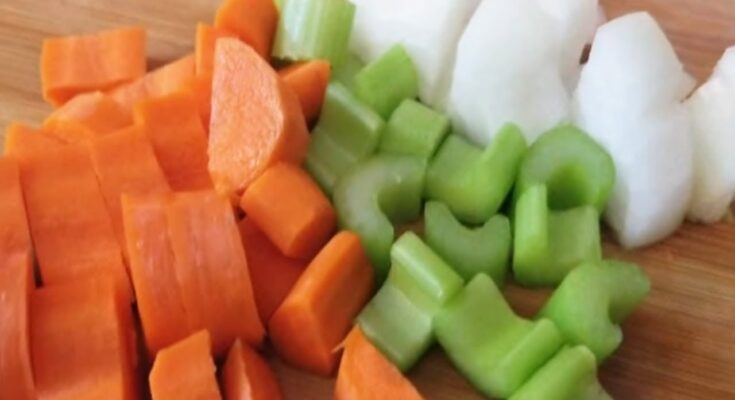Mirepoix Recipe: Let’s start with the basics—what exactly is mirepoix? Pronounced “meer-pwah,” this humble blend of chopped onions, carrots, and celery is the quiet hero of the kitchen. It’s not flashy. It’s not spicy. But it is foundational. Mirepoix is a classic French flavor base used to build depth and richness in countless dishes, from soups to sauces to braised meats. Traditionally, mirepoix is made with two parts onion to one part each of carrot and celery. This magical trio slowly cooked in fat—usually butter or oil—forms a flavorful backdrop that brings complexity and aroma to your recipes.
Whether you’re whipping up a rich beef stew or a light chicken soup, mirepoix sets the stage. Think of it like the rhythm section in a band. You don’t always notice it outright, but without it, everything else falls flat. It’s not just a combination of vegetables; it’s a technique that requires time, patience, and a little love.
Why Mirepoix is a Culinary Staple
Why is this simple mix such a big deal in the culinary world? Because it’s incredibly versatile. Mirepoix acts as the foundation for a wide variety of recipes across different cuisines. While the ingredients themselves are basic pantry staples, the technique of gently sweating them together creates a natural sweetness and savory depth that elevates dishes to restaurant-level quality.
The slow cooking process caramelizes the natural sugars in the vegetables, enhancing their flavors without overpowering them. That’s why chefs and home cooks alike swear by it. Plus, you can customize mirepoix to suit your taste or the dish you’re preparing. Add garlic, herbs, or spices, and it takes on a whole new dimension.
In short, mirepoix is a cornerstone of cooking that no kitchen should be without.
Ingredients You’ll Need
Core Vegetables in Traditional Mirepoix
When preparing a traditional French mirepoix, you only need three simple vegetables:
- Onions – Yellow onions are most commonly used for their mild, sweet flavor. Red onions can be too strong, and white onions can be too sharp.
- Carrots – Peel them before chopping to avoid any bitterness. They bring sweetness and color to the mix.
- Celery – The unsung hero that brings freshness and that slightly peppery bite.
The golden ratio here is 2:1:1 — two parts onion to one part carrot and one part celery. This ensures that the onions provide the dominant sweetness and moisture while the carrots and celery complement and balance the flavor.
Here’s a simple measurement for a basic batch:
- 2 cups diced onions
- 1 cup diced carrots
- 1 cup diced celery
Make sure your veggies are fresh and firm. Wilted celery or soft carrots won’t do the trick—they’ll break down too fast and lack the flavor you want in a proper mirepoix.
Optional Additions and Variations
While traditional mirepoix sticks to the big three, there’s room to experiment depending on your dish:
- Garlic – Adds pungency and depth, great for Italian dishes.
- Leeks – Softer and sweeter than onions, perfect for more delicate soups.
- Herbs – Bay leaves, thyme, and parsley stems add layers of aroma.
- Tomato Paste – Not traditional in French mirepoix, but common in darker sauces and gravies.
For those watching their carbs, you can also substitute parsnips for carrots or use fennel in place of celery to add a twist.
Tools and Equipment You’ll Need
You don’t need fancy kitchen gadgets to make mirepoix, but the right tools make it easier:
- Sharp Chef’s Knife – Precision matters. A dull knife will bruise your veggies.
- Cutting Board – Preferably wooden or plastic, large enough to handle all your chopping.
- Heavy-Bottomed Pan or Dutch Oven – For even, low-heat cooking without burning.
- Wooden Spoon or Silicone Spatula – For gentle stirring that won’t damage your pan.
That’s it! With the right ingredients and tools, you’re ready to get cooking.
The Role of Mirepoix in Cooking
How It Enhances Flavor
You might be wondering, how can three basic vegetables make such a difference? It’s all about the Maillard reaction—a chemical process that happens when you slowly cook vegetables, especially onions, at low heat. The sugars begin to caramelize, unlocking a rich, savory-sweet depth of flavor.
Mirepoix doesn’t scream for attention. Instead, it whispers flavors into the background, making your dish taste fuller, more developed, and well-balanced. In soups, it lends a comforting aroma. In sauces, it rounds out the acidity. In braises, it becomes part of the sauce, melting into the meat and liquid to create harmony on the plate.
Because it cooks slowly and gently, mirepoix isn’t about instant gratification. It’s about patience—letting the ingredients release their flavors gradually, and trusting the process.
Dishes That Use Mirepoix
Mirepoix is the backbone of many iconic recipes. You may not see it listed on the menu, but trust me—it’s there, working its magic behind the scenes.
Some dishes that rely heavily on mirepoix include:
- Soups and Stews: Chicken noodle soup, beef stew, minestrone
- Stocks and Broths: Vegetable stock, chicken broth, veal stock
- Sauces: Espagnole sauce, Bolognese, gravy
- Braised Dishes: Pot roast, coq au vin, osso buco
Even when it’s strained out before serving, the mirepoix has done its job by imparting flavor into the cooking liquid. In many ways, it’s the unsung hero of classic comfort food.
Step-by-Step Guide to Making Mirepoix
Step 1: Washing and Peeling the Vegetables
Mirepoix starts with the holy trinity of French flavor—onions, carrots, and celery. Begin by thoroughly washing your vegetables under cold water to remove any dirt or residue. Peel the carrots and onions, trimming off the ends and any blemishes. If your celery has fibrous strands, remove them for a smoother texture. This step sets the stage for a clean, balanced base that enhances any dish you build on it—soups, sauces, stews, or roasts.
Step 2: The Proper Mirepoix Dice Technique
A classic mirepoix follows a 2:1:1 ratio—two parts onion, one part carrot, and one part celery. Dice each vegetable into small, even pieces (about ¼ inch cubes). The key is uniformity—equal-sized cuts mean everything cooks evenly and releases flavor at the same pace. For rustic dishes like pot roast or chicken stock, a rough chop works fine. For refined sauces or soups, go finer. Think of it as the foundation of your culinary architecture—precise cuts, strong flavor.
Step 3: Cooking the Mirepoix – Low and Slow
Heat a tablespoon or two of butter or oil in a skillet or heavy-bottomed pot over medium-low heat. Add your diced vegetables and cook slowly, stirring occasionally. The goal is sweating, not browning—the vegetables should soften and release their natural sweetness without caramelizing. This gentle process usually takes about 10–15 minutes. The aroma at this stage is the heartbeat of French cuisine—warm, sweet, and deeply savory.
Step 4: Adjusting for Different Cuisines
Mirepoix may be French-born, but its influence spans continents. You can tweak it to match the flavor base of different cuisines:
- Italian: Add garlic and tomatoes for a soffritto.
- Cajun/Creole: Replace carrots with bell peppers to make the “holy trinity.”
- Spanish: Include garlic, tomato, and olive oil for a sofrito twist.
- Asian: Swap carrots for ginger and add scallions for an aromatic backbone.
Every great cuisine starts with its version of mirepoix—it’s not just diced vegetables; it’s the quiet hero behind the world’s best dishes.
Mirepoix Variations Across Cultures
French Mirepoix
Let’s start with the original. In classic French cuisine, mirepoix is the bedrock of flavor. It’s usually made with white or yellow onions, carrots, and celery in a 2:1:1 ratio. The vegetables are sweated slowly in butter or oil, never browned, and are often strained out after cooking—especially in stocks and sauces.
Some French recipes use white mirepoix, omitting carrots and using leeks and parsnips instead to keep the base light in color, especially for delicate sauces or light-colored stocks like fish fumet.
It’s a technique passed down through generations and taught in culinary schools worldwide. French chefs treat mirepoix with respect—and so should you.
Italian Soffritto
Italy takes mirepoix and adds a splash of intensity. Known as soffritto, the base is similar—onion, carrot, and celery—but it’s typically finely chopped and sautéed in olive oil instead of butter.
Unlike French mirepoix, soffritto is often left in the dish and becomes a visible part of sauces like ragù, Bolognese, and risotto. Italians may also include garlic, parsley, or tomato paste, adding boldness and richness to the base. It’s punchier and designed to stand up to big flavors like red wine, meat, and tomatoes.
Cajun Holy Trinity
In the American South, particularly Louisiana, the Holy Trinity takes the place of mirepoix. Instead of carrots, Cajun and Creole cooks use green bell peppers, creating a more savory and slightly bitter base.
The typical ratio here is still 2:1:1, but the flavor is bolder, spicier, and perfect for dishes like gumbo, jambalaya, and étouffée. Many cooks will also add garlic, scallions, and even hot sauce during the cooking process to bring out that signature Cajun flair.
This version isn’t just about subtlety—it’s about building bold, in-your-face flavor from the ground up.
Tips and Tricks for Perfect Mirepoix
Getting the Ratios Right
The magic of mirepoix lies in its balance. The traditional French ratio is 2 parts onion, 1 part carrot, and 1 part celery. This combination works because each ingredient plays a specific role:
- Onions provide sweetness and body.
- Carrots offer color and natural sugars.
- Celery delivers freshness and a hint of bitterness to balance everything out.
But don’t be afraid to adjust. Cooking is part science, part art. Want a slightly sweeter base? Add more carrots. Need something with more bite? Increase the celery. Just remember that drastic changes can throw off the flavor profile, so experiment in small batches.
Here are a few suggested ratios for different results:
- Classic balance: 2:1:1 (onion:carrot:celery)
- Sweeter flavor: 2:2:1
- Bitter & aromatic: 2:1:2
When in doubt, stick to the classic. It’s called a foundation for a reason.
Storing and Freezing Mirepoix
One of the best things about mirepoix? You can make it in advance and store it for later use. That’s a lifesaver for busy weeknights or when you’re batch cooking.
Storage Tips:
- Fridge: Store cooled, cooked mirepoix in an airtight container for up to 5 days.
- Freezer: Portion out cooled mirepoix into zip-top bags or silicone freezer trays. Label them with the date and freeze for up to 3 months.
Want to keep things even simpler? You can freeze raw, pre-diced vegetables separately in bags. That way, you always have your mirepoix ingredients ready to go when it’s time to cook.
Pro Tip: Freeze mirepoix in ½ cup or 1 cup portions so you can easily grab the amount you need without defrosting a whole batch.
Common Mistakes to Avoid
Overcooking or Browning
One of the most common errors when cooking mirepoix is turning up the heat too high. Mirepoix isn’t about speed; it’s about gentle, low-temperature cooking. When you brown the vegetables, you’re caramelizing them, which creates a different, often overpowering flavor.
You want to sweat the vegetables, not sear them. This means cooking them just enough to soften and release moisture without taking on color. The idea is to extract the natural sweetness and allow the vegetables to meld into the background of the dish—not dominate it.
To avoid browning:
- Use medium-low heat
- Stir occasionally
- Don’t overcrowd the pan
- Cook slowly and patiently
If you see browning, reduce the heat and stir more frequently.
Using the Wrong Vegetable Ratios
It might seem harmless to throw in a handful of extra carrots or onions, but changing the ratios too much can drastically affect your final dish. Too many carrots, and your mirepoix becomes overly sweet. Too much celery, and it might taste bitter or green.
Each vegetable is there for a reason, and their flavors work in harmony. Stick to the standard ratio unless you’re intentionally creating a variation for a specific cuisine or dish.
Another misstep? Using poor quality or old vegetables. Since mirepoix is all about building flavor, starting with limp celery or soft, sprouting onions is a sure way to start off on the wrong foot.
Nutritional Benefits of Mirepoix
Health Benefits of Each Ingredient
You might think mirepoix is just for flavor, but it also packs a nutritional punch. Let’s break down the benefits of each core ingredient:
- Onions: Rich in antioxidants, particularly quercetin, which has anti-inflammatory and heart-healthy benefits. Onions also contain vitamin C, fiber, and folic acid.
- Carrots: Famous for their high beta-carotene content, which converts to vitamin A in the body, supporting healthy vision and immune function. They’re also a good source of fiber and potassium.
- Celery: Low in calories but high in water and fiber, celery helps with digestion and hydration. It also contains antioxidants like apigenin and luteolin that can reduce inflammation.
Combined, these ingredients create a flavorful base that’s not just delicious, but good for you too. Mirepoix adds complexity to meals without the need for excess salt, sugar, or fat, making it a healthier choice for flavor enhancement.
Mirepoix in a Balanced Diet
Because mirepoix is usually used as a base ingredient, it adds nutritional value to your dishes without being the main event. That said, incorporating mirepoix into your regular cooking can reduce reliance on processed flavor enhancers like bouillon cubes or seasoning packets.
If you’re meal-prepping or following a whole-food diet, mirepoix is your best friend. It’s:
- Low in calories
- Nutrient-dense
- Flexible with dietary preferences (vegan, paleo, keto)
You can even blend mirepoix into purees or sauces for picky eaters who don’t like chunks of vegetables. It’s a stealthy way to boost veggie intake.
FAQs about Mirepoix Recipe
Can I make mirepoix in advance?
Absolutely. You can prepare and refrigerate it for up to 5 days or freeze it for up to 3 months. Cooked or raw—it stores well either way.
Is mirepoix the same as sofrito?
Not exactly. Mirepoix is French and includes onion, carrot, and celery. Sofrito is Spanish/Latin and often includes garlic, tomato, and peppers—different ingredients and cultural roots.
Can I freeze mirepoix?
Yes! Freeze it in small portions so it’s easy to grab what you need. Ice cube trays, small containers, or freezer bags all work great.
What’s the best oil to use for cooking mirepoix?
That depends on the cuisine. Butter is great for French recipes, olive oil for Italian, and vegetable oil works fine for neutral applications.
Can mirepoix be eaten on its own?
It’s not usually eaten solo, but you could. It’s more of a flavor base than a dish by itself—kind of like trying to eat pie crust without the filling. Tasty, but missing the point.
Conclusion
Mirepoix may seem simple—just chopped vegetables cooked slowly—but it’s one of the most powerful tools in your kitchen arsenal. It’s the quiet foundation that builds bold flavors. Whether you’re a beginner learning the ropes or a seasoned chef fine-tuning your flavors, mastering mirepoix is a step toward cooking like a pro.
From French classics to Cajun feasts, this trio of onion, carrot, and celery brings depth, warmth, and heart to any meal. Now that you’ve got the step-by-step guide, the tips, and even the cultural variations, it’s time to chop, sweat, and stir your way to better home cooking.
So next time you’re about to start a soup or sauce, don’t skip the mirepoix. Embrace it. Respect it. Let it be the flavor foundation your dish deserves.



